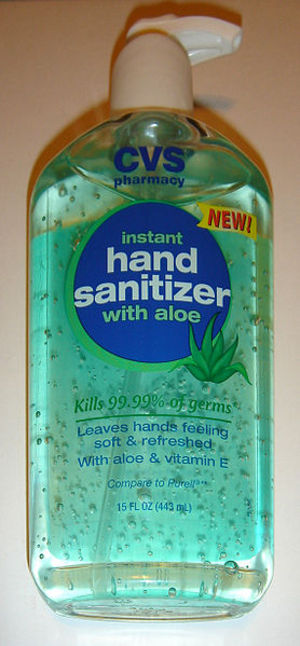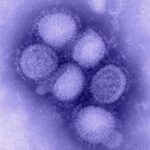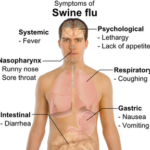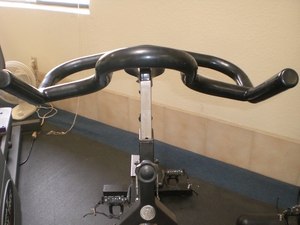Despite concerns all over about H1N1 swine flu some North American schools are not permitting children to bring hand sanitizer in from home. School districts in Manitoba, Nova Scotia and Florida have been fielding inquiries from parents and staff about the safety of the alcohol-based sanitizers, and there have even been calls to ban the products outright.
Apprehensions are the result of reports that there have been incidents of alcohol poisoning due to people, especially small children, ingesting the sanitizer. To be effective the products has to contain a minimum of 60 percent alcohol, which is comparable to the alcohol content in 120 proof whiskey. Experts say that it would only take three squirts from a bottle to make a preschooler very ill, and if the child managed somehow to consume more, there is enough ethyl alcohol in the bottle to kill. There has also been at least one instance in which a secondary school student was accused of trying to inhale the fumes from the sanitizer, in order to get high.
Other worries are that students who have been using sanitizer on their hands could be in danger when plugging in electrical equipment in school laboratories: a spark could be created and the student would be burned, one school nurse claimed. Then there is the question of whether the bottles of sanitizer pose a fire hazard, themselves. Although fire safety personnel have confirmed that any quantity of alcohol does pose a fire hazard, they are not recommending any special safety measures for the smaller pump bottles many of us keep on our desks and in our homes. Larger containers of sanitizer, however, do have to be stored with caution. Schools that stock these containers would be expected to follow existing fire safety protocols.
Although the possibility of abuse or accident does exist, I’ve got to say so far I haven’t seen any statistics that indicate the frequency of such occurrences. Well, actually, that’s not true: the school nurse was discussing a possibility, as are all those who are afraid of the fire hazards linked to products containing alcohol. As for accidental poisonings, all the discussion has been about toddlers and preschoolers who drank or licked the sanitizer at home. Finally, the abuse by the high school student was accused but appears not to have gone beyond that stage. So, overall, the likelihood of students getting hurt using hand sanitizer at school seems very low.
The sanitizers do serve a useful purpose, however, in reducing transmission of communicable diseases in general. While droplet or aerosol transmission from sneezing and coughing are also important sources of infection, many of the illnesses we catch can be better controlled through proper handwashing, and in a school environment washing is not always possible. Many schools complain of not having enough sinks to allow for all students to wash up before snacks and meals, and after playing at recess. And sending students out of the classroom to wash after every sneeze would obviously disrupt learning.
Furthermore, research conducted by Children’s Hospital Boston showed that using alcohol-based hand sanitizers reduced transmission of infectious illnesses over a program that taught proper handwashing and promoted more frequent washing. This is a very good reason to resist any moves to ban sanitizers from the school environment, which is a particularly good place to visit if a person wants to get sick!
Suggesting that we not allow students to use hand sanitizers because of a very small potential for misuse or fire is foolhardy, especially when we consider their benefits. We do live in a society that leans towards bubble wrapping children at birth and not allowing them to face the dangers of the real world until the age of majority, this is true. However we have not yet banned paper or books from schools These are quite flammable, or so I hear. And children regularly suffer from both paper cuts and back strain resulting from carrying too many heavy books back and forth to school. Nor have we banned stair cases or balls, balance beams and ropes in gym classes. All of these can be tied to injuries, some of which necessitate an emergency room visit. And just think what chemicals are present in a school janitorial closet or science lab!
All of these are sources of danger to our students and yet we are not considering banning chemistry classes or the proper cleaning of our school buildings. Nor have we begun looking into laws that would see all schools built on a single floor, or policies that would require students to keep at least one foot in contact with the floor at all times. Perhaps those who fear our children will get drunk on their hand cleansers and burn their hands plugging in the overhead projector haven’t given much thought to lighting a Bunsen burner! Oh, the average school is a playground for the overactive adult imagination!
There are non-alcohol sanitizers available, but these products can be less effective in preventing transmission of illness. However, if a school is going to prevent students from using alcohol-based sanitizers it does not seem unreasonable that other products such as these alternative sanitizers be provided to students – especially in schools where there are not enough sinks to allow all students to wash up.
Parents are advised to find out what the current policies and practices are regarding handwashing and sanitizers in their child’s school, and to watch for any updates. If it is clear that students are not being allowed to clean their hands when appropriate, it is in the best interests of the children for parents and schools to see this changes promptly.
Sources:
Booze Ooze” Barbara Mikkelson (Urban Legends Reference Pages)
“Could kids get sick from hand sanitizer?” Marisa Mendelson (Fox4)
“Despite swine flu, some take shots at hand sanitizer” Noreen S. Ahmed-ullah (Chicago Tribune)
Reference:
- Purell Instant Hand Sanitizer Kills Germs and Skin at the Same Time www.associatedcontent.com/article/570303/purell_instant_hand_sanitizer_kills.html
- Crocheted Hand Sanitizer Key Chain Holder www.associatedcontent.com/article/2038285/crocheted_hand_sanitizer_key_chain.html
- The Hidden Dangers of Hand Sanitizer www.associatedcontent.com/article/1450450/the_hidden_dangers_of_hand_sanitizer.html








